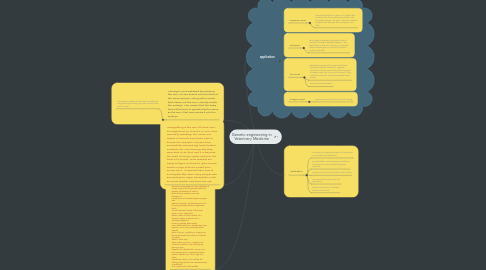Genetic engineering in Veterinary Medicine
создатель MAISYARAH BINTI ABU SAMAH


1. GENETIC ENGINEERING: the collection of a wide array of techniques that alter the genetic constitution of cells or individuals by selective removal, insertion, or modification of individual genes or gene sets GENE CLONING: the development of a line of genetically identical organisms which contain identical copies of the same gene or DNA fragments GENE THERAPY: the insertion of a functional gene or genes into a cell/tissue/organ to correct a genetic abnormality PCR: abbreviated from polymerase chain reaction, an in vitro process by which specific parts of a DNA molecule or a gene can be rapidly made into millions or billions of copies within a short time RECOMBINANT DNA: a hybrid DNA molecule created in the test tube by joining a DNA fragment of interest with a carrier DNA SOUTHERN BLOT: a procedure that is used to transfer DNA from a gel to a nylon membrane, which in turn allows the finding of genes that are complementary to particular DNA sequences called probes
2. Xenografting is the use of human DNA to supplement an animal's or vice versa. Generally speaking, the valves and tissues of animals have been used in humans for example, humans have successfully received pig hearts before. Scientists are now learning why they were able to do that, and it is because the heart of a pig is quite similar to the heart of a human. Now scientist are trying to figure out how to grow human hearts in pigs, that are coded from human DNA. If scientist learn how to accomplish this, than many people who are waiting for organ transplants could be saved quicker and have less risk.
3. Cloning is accomplished by inserting the DNA of one animal into the fetus of the same species, along with a vector that cleans out the DNA already inside the embryo. This means that the baby that will be born is genetically the same as the DNA that was inserted into the embryo.
3.1. Cloning is currently only focused on cattle with the goal of reproducing the cows with the best milk or meat.
4. definition
4.1. to reveal the complex processes of how genes are inherited and expressed
4.2. provide better understanding and effective treatment for various diseases,(genetic disorder)
4.3. to generate economic benefits which include
4.4. improved plants and animals for agriculture
4.5. efficient production of valuable biopharmaceuticals
5. application
5.1. companion animal
5.1.1. scientist extracted the genes of a jellyfish that coded for the fluorescent proteins that make the jellyfish glow in the dark. They then inserted this gene into zebrafish that now glow in the dark
5.2. wild animal
5.2.1. technology is applied to bring back extinct species or saving endangered species. This application mainly uses cloning. For example, some scientists plan on cloning the extinct woolly mammoth.
5.3. farm animal
5.3.1. generally engineered for productivity, food quality and disease resistance. Pigs and chickens have been genetically altered to grow at quicker rates than a normal one would. They could also make the animals have better food quality
5.3.2. become disease resistant
5.4. transgenic animal
5.4.1. engineered specifically for scientific testing
